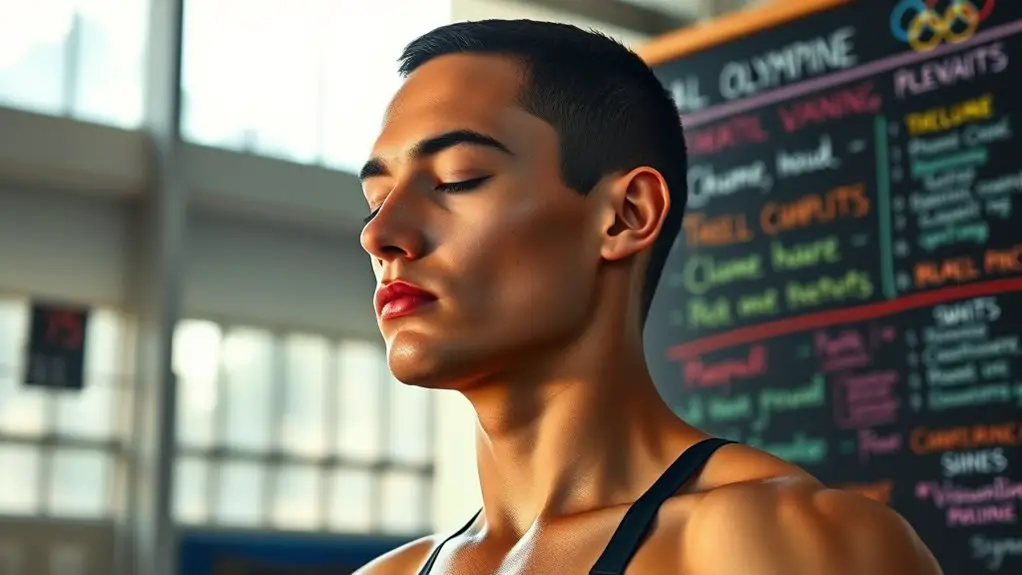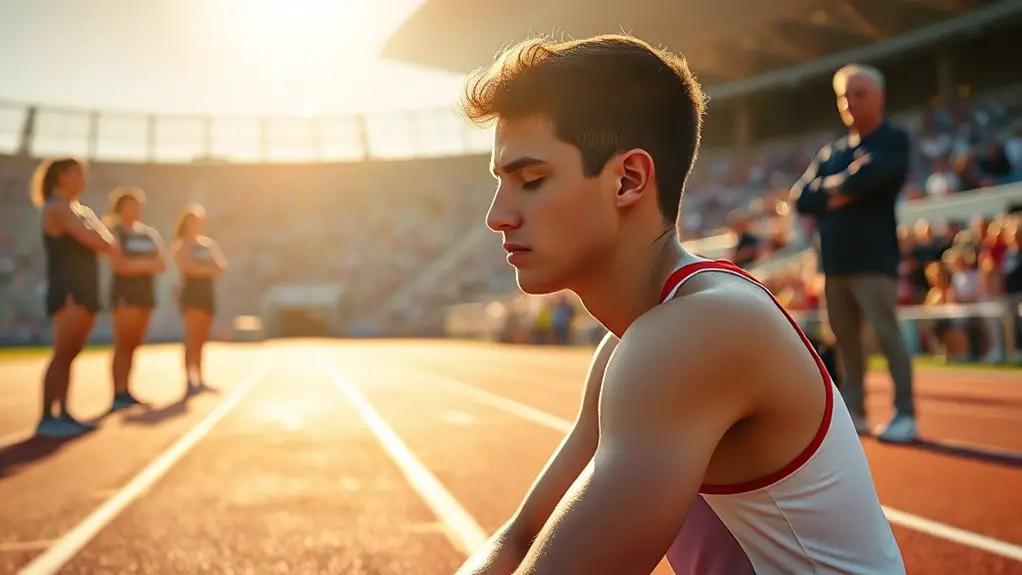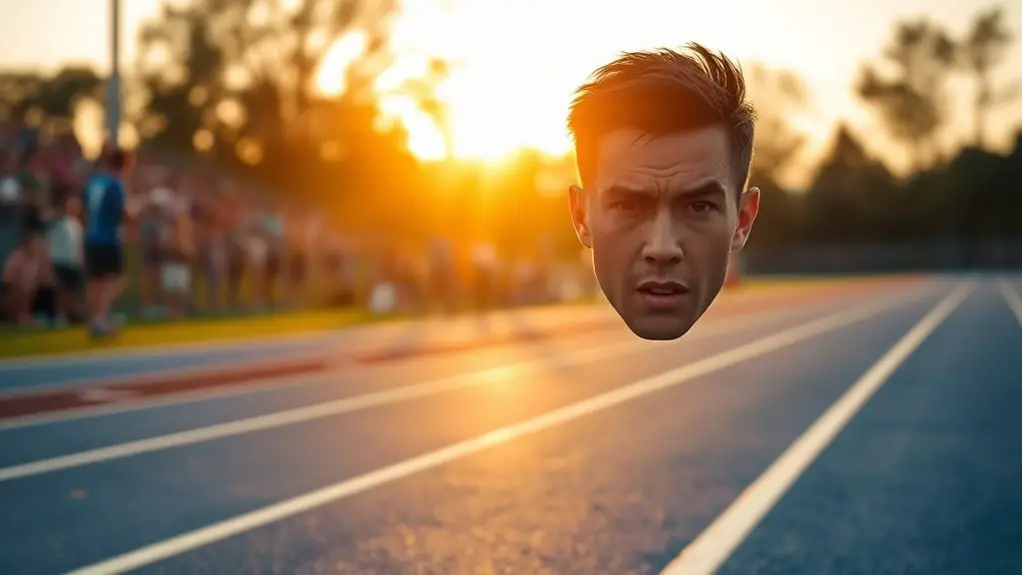Olympians use powerful visualization techniques to boost performance and confidence. They vividly imagine executing skills, focusing on all senses, which aids in muscle memory and creates emotional connections. Pre-performance routines are enhanced by combining visualization with focused breathing, calming nerves effectively. Visualizing success and positive outcomes conditions your mind for achievement. Tailoring these techniques to specific sports maximizes their impact. Discover how these strategies transform athletes into champions and uncover more about their training methods.
The Power of Mental Imagery
While you might think of physical training as the key to an athlete's success, mental imagery plays an essential role in their preparation. This powerful tool allows you to visualize your performance in vivid detail, creating a mental rehearsal of your routines and strategies. Imagine standing on the starting line or facing a competitor—every movement, every breath can be crafted in your mind.
Harnessing mental imagery empowers you to conquer fears and boost confidence, making you more resilient in high-pressure situations. It's like giving your mind a taste of victory before it even happens. By consistently practicing these visualizations, you're not just thinking; you're conditioning your brain to respond effectively. Incorporating visualization and mental preparation techniques can further enhance your performance.
This mental training can be your edge, enhancing your focus and clarity when it matters most. Embracing the power of mental imagery may just be the freedom you need to elevate your game and achieve your athletic dreams.
Visualization for Skill Mastery
When it comes to mastering a skill, visualization can be your secret weapon. You can use mental rehearsal techniques to picture yourself executing movements perfectly, enhancing your performance. With focused concentration practices, you'll find it easier to block out distractions and maintain peak mental clarity. Additionally, practicing muscle memory through visualization can lead to instinctive reactions during high-pressure situations.
Mental Rehearsal Techniques
Mental rehearsal techniques are a powerful tool for athletes aiming to master their skills. By vividly imagining yourself executing a skill perfectly, you're not just dreaming; you're training your brain. You can visualize each movement, feeling the rhythm and flow, as if it's happening in real time. This mental practice helps solidify connections in your brain, making your actual performance smoother and more instinctive. You can create scenarios where you encounter challenges, allowing you to prepare mentally for any situation. It's all about freedom—freedom to explore your potential without the restraints of physical limitations. Embrace this technique, and you'll find that you can enhance your skills while building confidence that transcends the field or court.
Imagery for Performance Enhancement
Building on the idea of mental rehearsal, imagery for performance enhancement takes visualization a step further by incorporating sensory details and emotions into your practice. When you visualize, don't just see yourself performing; feel the adrenaline coursing through your veins, hear the crowd's cheers, and smell the fresh air of competition. Imagine the textures, the sounds, and even the emotions you'd experience during your performance. This vivid imagery creates a more powerful connection to your skills, helping you master them. By engaging all your senses, you'll enhance your confidence and focus, making it easier to replicate these feelings in real-life situations. Let your imagination run wild; the freedom of visualization can reveal your true potential as an athlete.
Focused Concentration Practices
Although visualization is often associated with performance enhancement, focused concentration practices specifically target skill mastery by honing your ability to concentrate on intricate details. You can improve your technique by engaging yourself in vivid mental imagery. Picture each movement, feel the rhythm, and embrace the sensations. This sharp focus allows you to break down complex skills into manageable parts, making mastery feel attainable. Regularly practicing these techniques helps you cultivate a deep awareness of your body and its mechanics. As you visualize, you're not just dreaming; you're programming your mind and body for success. When you're free to explore these practices, you'll find confidence growing, leading to improved performance and a more profound connection with your sport. Immerse yourself and access your potential!
Creating a Pre-Performance Routine
Creating a pre-performance routine can be a game-changer for your mental state. By incorporating mental imagery practice and focused breathing techniques, you'll enhance your focus and calm your nerves. Consistency in these practices is key, helping you perform at your best when it counts. Additionally, mindfulness in athletic performance promotes presence and engagement, allowing you to tune out distractions and concentrate fully on your game.
Mental Imagery Practice
Many athletes find that mental imagery practice is a powerful tool for enhancing performance. By visualizing your routine before an event, you create a mental rehearsal that can boost your confidence and focus. Picture every detail: the feel of the equipment, the sounds of the crowd, and the sensations in your body. This isn't just daydreaming; it's about immersing yourself in the experience you want to achieve. You can even imagine overcoming obstacles and executing your techniques flawlessly. The more vivid your imagery, the more effective it'll be. Incorporate this practice into your pre-performance routine, and you'll likely notice a shift in your mindset, empowering you to tackle challenges with a newfound sense of freedom and control.
Focused Breathing Techniques
After engaging in mental imagery practice, you can enhance your pre-performance routine by incorporating focused breathing techniques. These techniques help you ground yourself, clear your mind, and center your energy. Start by finding a comfortable position, whether sitting or standing. Close your eyes and take a deep breath in through your nose, filling your lungs completely. Hold it for a moment, then exhale slowly through your mouth, letting go of any tension. Repeat this process a few times, focusing solely on your breath and how it feels. As you breathe, visualize the calmness washing over you, preparing you for the challenge ahead. By mastering focused breathing, you'll create a sense of freedom and control that empowers your performance.
Visualization Consistency Importance
While athletes often rely on mental imagery to enhance performance, the key to maximizing its effectiveness lies in the consistency of practice. Creating a pre-performance routine that you can stick to is essential. When you visualize regularly, your mind learns to associate specific images with peak performance, reinforcing your confidence and focus. Think of it as tuning an instrument; the more you practice, the more finely tuned your mental game becomes. You should incorporate visualization into your daily training, making it a non-negotiable part of your preparation. This consistency not only sharpens your skills but also helps you stay relaxed and in control when it matters most. Embrace the freedom that comes with a solid routine, and watch your performance soar.
Overcoming Anxiety and Building Confidence
Although anxiety can be a common hurdle for athletes, effective visualization techniques can help you overcome it and build confidence. By tapping into your imagination, you can create a mental environment that fosters calm and assurance. Here are three visualization techniques to evaluate:
- Relaxation Imagery: Picture a serene setting where you feel at ease. This can lower your heart rate and clear your mind before competition.
- Positive Affirmations: Visualize yourself succeeding while repeating empowering statements. This reinforces your mindset and helps you believe in your capabilities.
- Pre-Performance Routines: Imagine your warm-up and competition sequences in detail. This mental rehearsal can ease anxiety and prepare you for what's to come. Additionally, incorporating mindfulness meditation techniques can further enhance your focus and reduce stress levels, leading to improved performance.
Visualizing Success and Positive Outcomes
When you visualize success, you're not just dreaming; you're actively shaping your reality. Picture yourself crossing that finish line, feeling the exhilaration of victory wash over you. This mental imagery isn't just a fleeting thought; it's a powerful tool that can transform your performance. When you focus on positive outcomes, you're programming your mind to expect success, which can boost your confidence and motivation.
Imagine the sounds of applause and the joy of achieving your goals. This clarity helps you align your actions with your aspirations, making you more resilient in the face of challenges. You're creating a mental blueprint that guides your physical efforts, allowing you to overcome obstacles with ease. Moreover, regular practice of visualization techniques builds a strong mental framework that complements your physical training.
Integrating Visualization With Physical Training
Visualizing success can be even more powerful when combined with your physical training. Imagine the feeling of your body moving effortlessly as you perform each technique. To fully harness this synergy, consider these three steps:Visualizing success enhances your physical training, allowing your body to move effortlessly through each technique.
- Mental Rehearsal: Before you hit the gym or the track, take a few minutes to visualize yourself executing your workout perfectly. Picture every movement, every breath, and how your body feels in peak condition.
- Set Clear Intentions: While training, set specific visual goals. Whether it's mastering a jump or hitting a speed target, align your mental images with your physical efforts.
- Reflect and Adjust: After your training session, reflect on both your physical performance and your visualization. Did they match? If not, adjust your mental imagery to better support your physical training goals.
Tailoring Techniques to Specific Sports
To maximize the effectiveness of visualization techniques, it's essential to tailor them to the specific demands of your sport. Each discipline has unique physical and mental challenges, so adapting your approach can enhance your performance. For instance, if you're a sprinter, visualize the explosive start and perfect stride technique. Picture every detail, from your foot striking the ground to the finish line ahead.
On the other hand, if you're a gymnast, focus on the precision and grace required for each routine. Imagine yourself executing flawless flips and landings, feeling the thrill of success.
Real-Life Examples of Olympians Using Visualization
Many Olympians have successfully harnessed the power of visualization to enhance their performance, demonstrating how tailored mental imagery can lead to tangible results. Here are three inspiring examples that show how visualization can be a game-changer:
- Michael Phelps: Before every race, he visualized every stroke, turn, and even the feel of water against his skin, creating a vivid mental movie that prepared him for victory.
- Gabby Douglas: She used visualization techniques to mentally rehearse her routines, picturing herself successfully executing each move, which built her confidence before competitions.
- Usain Bolt: Bolt often pictured himself winning races, focusing on the joy of crossing the finish line, which helped him maintain a positive mindset and push through challenges.
These examples illustrate how visualization can release potential, giving you the freedom to break barriers and achieve your dreams. Why not embrace this powerful tool for your own journey?
Frequently Asked Questions
How Long Should Athletes Practice Visualization Techniques Each Day?
Ever wonder how a few minutes each day can transform your performance? You should aim for 10 to 20 minutes of visualization practice daily. It's a small commitment for the freedom to excel in your sport.
Can Visualization Replace Physical Training Entirely?
You can't rely solely on visualization to replace physical training. While it's a powerful tool for mental preparation, actual practice builds muscle memory and endurance, essential for achieving peak performance in any sport. Balance is key.
Are There Any Age Restrictions for Practicing Visualization?
There aren't any age restrictions for practicing visualization. Anyone can benefit from it, regardless of age. You can start at any point in your life, allowing you the freedom to enhance your mental skills and performance.
What Are Common Mistakes to Avoid in Visualization?
When you're painting a picture in your mind, avoid using vague images. It's like trying to navigate a maze without a map. Be specific, and don't forget to include emotions; they bring your vision to life!
How Can Coaches Support Athletes in Visualization Practices?
Coaches can support you by creating a safe space for practice, offering guidance on techniques, and encouraging regular sessions. They can also help you set clear goals, ensuring your visualization aligns with your personal aspirations.




